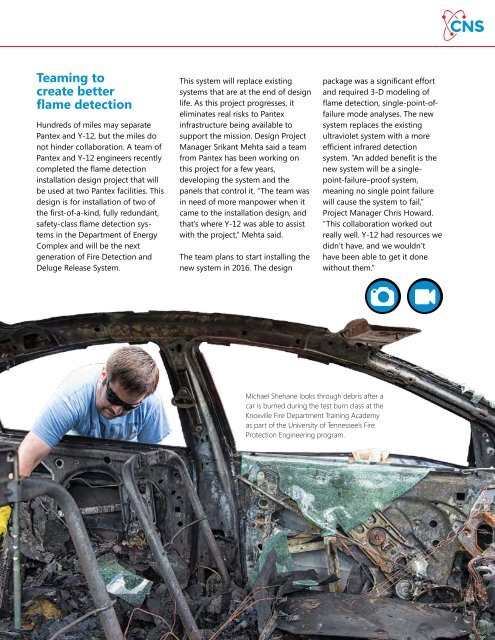THE STAR
The-Star-2015_Fall_web2
The-Star-2015_Fall_web2
You also want an ePaper? Increase the reach of your titles
YUMPU automatically turns print PDFs into web optimized ePapers that Google loves.
Teaming to<br />
create better<br />
flame detection<br />
Hundreds of miles may separate<br />
Pantex and Y-12, but the miles do<br />
not hinder collaboration. A team of<br />
Pantex and Y-12 engineers recently<br />
completed the flame detection<br />
installation design project that will<br />
be used at two Pantex facilities. This<br />
design is for installation of two of<br />
the first-of-a-kind, fully redundant,<br />
safety-class flame detection systems<br />
in the Department of Energy<br />
Complex and will be the next<br />
generation of Fire Detection and<br />
Deluge Release System.<br />
This system will replace existing<br />
systems that are at the end of design<br />
life. As this project progresses, it<br />
eliminates real risks to Pantex<br />
infrastructure being available to<br />
support the mission. Design Project<br />
Manager Srikant Mehta said a team<br />
from Pantex has been working on<br />
this project for a few years,<br />
developing the system and the<br />
panels that control it. “The team was<br />
in need of more manpower when it<br />
came to the installation design, and<br />
that’s where Y-12 was able to assist<br />
with the project,” Mehta said.<br />
The team plans to start installing the<br />
new system in 2016. The design<br />
package was a significant effort<br />
and required 3-D modeling of<br />
flame detection, single-point-offailure<br />
mode analyses. The new<br />
system replaces the existing<br />
ultraviolet system with a more<br />
efficient infrared detection<br />
system. “An added benefit is the<br />
new system will be a singlepoint-failure–proof<br />
system,<br />
meaning no single point failure<br />
will cause the system to fail,”<br />
Project Manager Chris Howard.<br />
“This collaboration worked out<br />
really well. Y-12 had resources we<br />
didn’t have, and we wouldn’t<br />
have been able to get it done<br />
without them.”<br />
Michael Shehane looks through debris after a<br />
car is burned during the test burn class at the<br />
Knoxville Fire Department Training Academy<br />
as part of the University of Tennessee’s Fire<br />
Protection Engineering program.<br />
7


